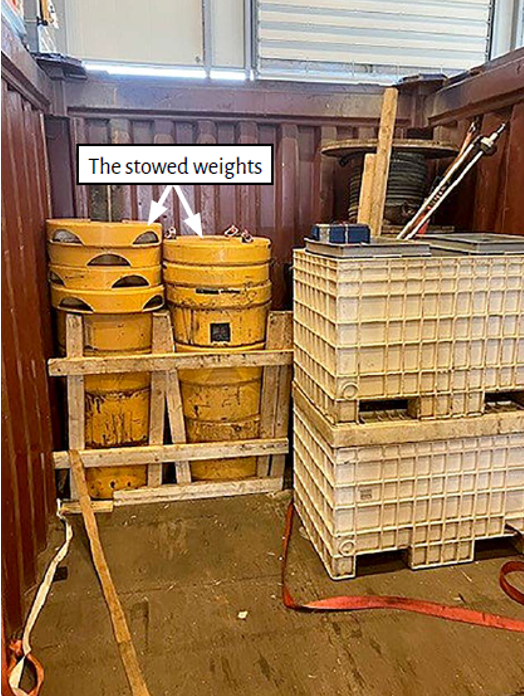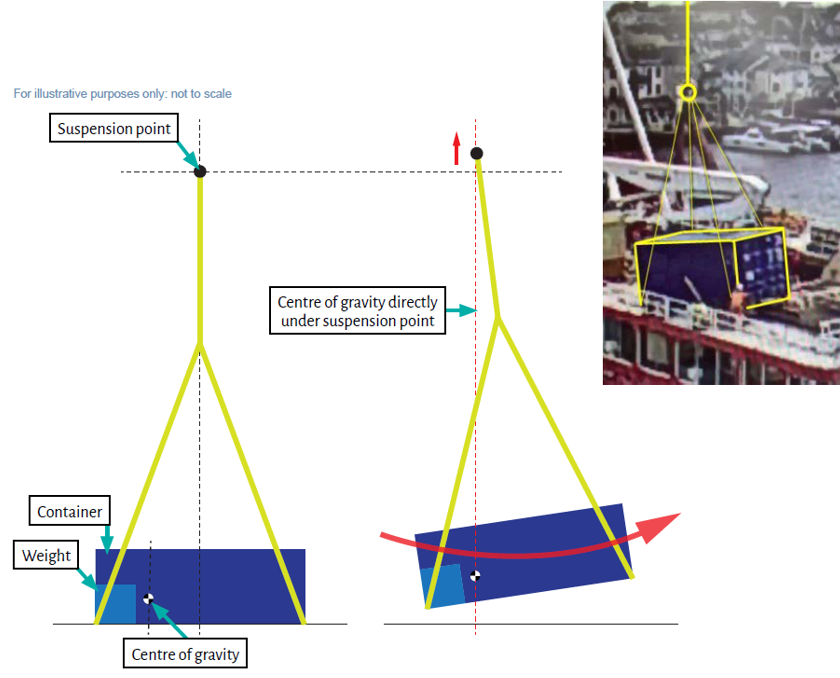MAIB: Shifting of centre-of-gravity of load
The UK Marine Accident Investigation Branch has published Safety Digest 2/2023, consisting of lessons from recent Marine Accident Reports. IMCA has reviewed the report and passes on to members, as some of the incidents in the MAIB report will be of interest. This is one of them.
What happened
A research vessel was unloading in port and crew had made a plan to offload a 20ft open-top container, which was filled with various pieces of equipment. A mobile crane on the jetty was being used to unload the ship; the crew prepared the lifting gear and attached four chains to the crane hook from the lifting lugs at each corner of the base of the container.
Three crew members were involved in the lift: the lift supervisor and banksman were positioned at the aft end of the container and the slinger was standing at the forward end. As the container was lifted it came clear of the twist locks that were securing it to the deck and rapidly swung aft and inboard. The lift supervisor was able to move out of the way, but the banksman suffered crush injuries when pinned between the container and the ship’s handrails.
What went wrong
The cargo was not secured properly and it shifted. Nearly 8 tonnes of weights had been stacked in the back corner of the container when the equipment was originally loaded into the container (Figure 1). When an unbalanced load is lifted, it will naturally swing to put its centre of gravity directly under the suspension point. Such a load will also alter the share of the weight that each part of the lifting gear bears. In this case, the imbalance from the stowed weights caused the container, which weighed more than 16t in total, to swing towards the banksman.


Lessons
The MAIB drew the following lessons:
- The distribution of load is as important as the total weight when preparing a lift and its effect on the lifting operation should be carefully considered in the total lifting plan. In this case, neither the crew on board nor the crane driver were prepared for the swing that the unbalanced load caused when the container was lifted;
- Always have an escape route. Stay alert and keep well clear of any suspended load just in case something goes wrong;
- Sometimes an unbalanced load will need to be lifted. To facilitate this, use slings of different lengths to lift the load directly above its centre of gravity or a spreader beam to evenly distribute the weight and make sure the load is lifted vertically.
Members may wish to refer to:
Safety Event
Published: 6 December 2023
Download: IMCA SF 28/23
IMCA Safety Flashes
Submit a Report
IMCA Safety Flashes summarise key safety matters and incidents, allowing lessons to be more easily learnt for the benefit of all. The effectiveness of the IMCA Safety Flash system depends on Members sharing information and so avoiding repeat incidents. Please consider adding [email protected] to your internal distribution list for safety alerts or manually submitting information on incidents you consider may be relevant. All information is anonymised or sanitised, as appropriate.
IMCA’s store terms and conditions (https://www.imca-int.com/legal-notices/terms/) apply to all downloads from IMCA’s website, including this document.
IMCA makes every effort to ensure the accuracy and reliability of the data contained in the documents it publishes, but IMCA shall not be liable for any guidance and/or recommendation and/or statement herein contained. The information contained in this document does not fulfil or replace any individual’s or Member's legal, regulatory or other duties or obligations in respect of their operations. Individuals and Members remain solely responsible for the safe, lawful and proper conduct of their operations.
